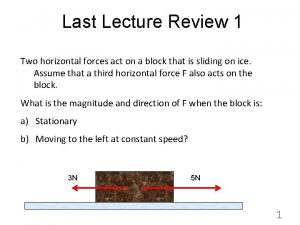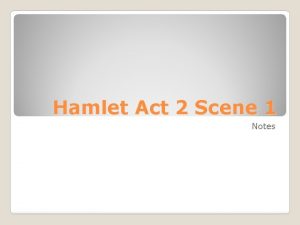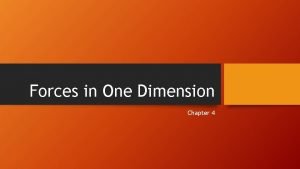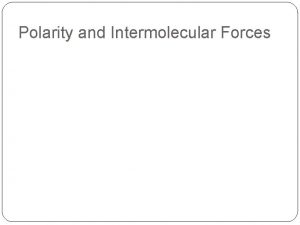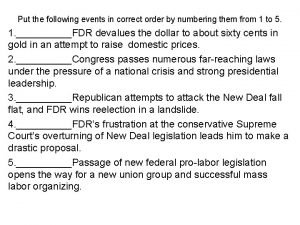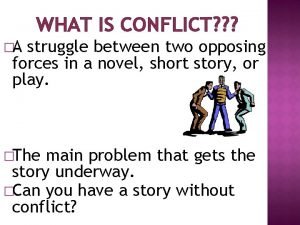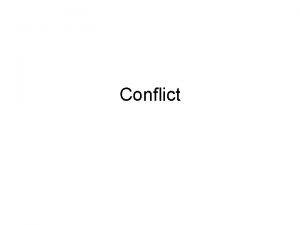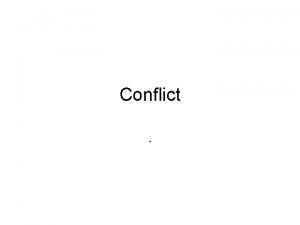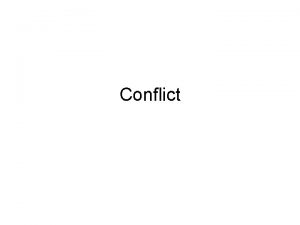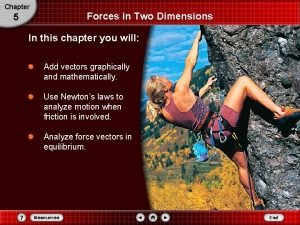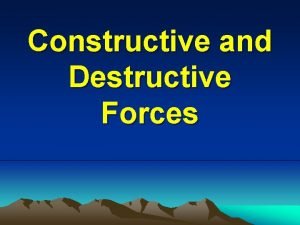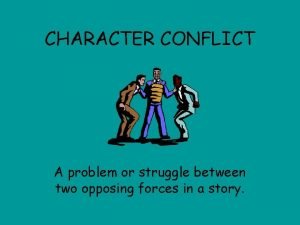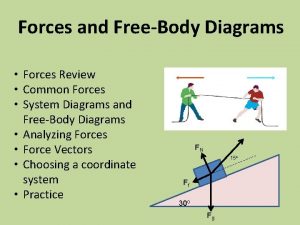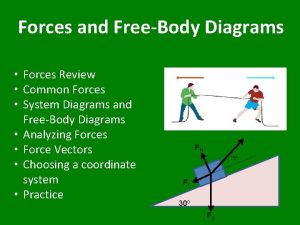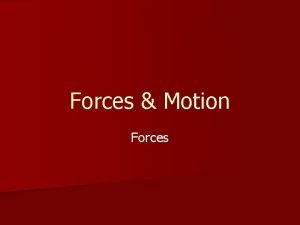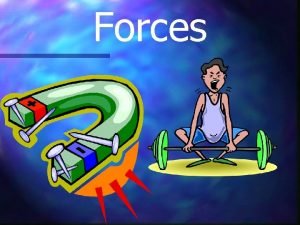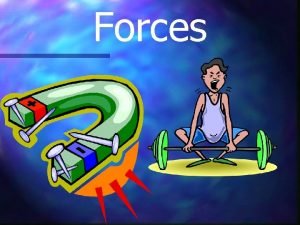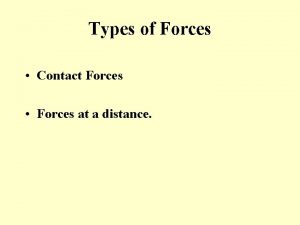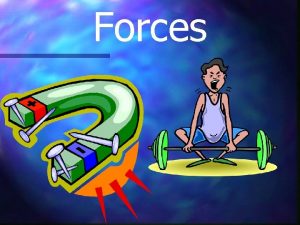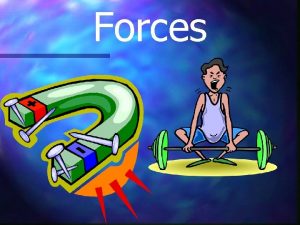Last Lecture Review 1 Two horizontal forces act

































- Slides: 33

Last Lecture Review 1 Two horizontal forces act on a block that is sliding on ice. Assume that a third horizontal force F also acts on the block. What is the magnitude and direction of F when the block is: a) Stationary b) Moving to the left at constant speed? 3 N 5 N 1

Last Lecture Review 2 In 3 minutes, describe to the person sitting next to you: a) What is a force? b) What change does a force (or system of unbalanced forces) make to a body? c) What is equilibrium? Then discuss with the class. 2

Last Lecture Review 3 Select the correct FBD at particle A. 30 A 40 100 N A) F 1 A B) 100 N C) F 30° A 100 N F 2 30 40° A D) F 1 30° F 2 40° A 100 N 3

Today: • Mechanical Units, Scalars and Vectors; • Statics: Forces and Equilibrium, Moments and Couples and Reactions, Centre of Gravity and Centroids, Distributed Force; • Dynamics: Constant velocity and constant acceleration in linear systems, circular systems; • Work, Power and Energy 4

Moments and Couples Objectives : Students will be able to: a) Calculate a moment and it’s direction; b) Solve problems involving moments of a force and couples in 2 D c) Calculate reaction forces 5

Moment in 2 -D F M d O The moment of a force about a point is a measure of the tendency for rotation (sometimes called a torque). 6

The magnitude of the moment about point O is: Mo = F. d where d is the perpendicular distance from point O to the line of action of the force F. In 2 -D, the direction of MO is either clockwise or anti-clockwise depending on the direction of the tendency for rotation. 7

a For example, MO = F. d F b and the direction is anti-clockwise. O d However, it is sometimes easier to determine MO by using the components of F as shown. F Fy a b O Fx 8

Moment at Knee with Distance Compare the applied moment at these leg positions. 9

F Fy Here, a b Fx MO = (FY a) – (FX b) O Note the different signs on the terms. The sign convention for a moment in 2 -D is anti-clockwise is positive. We can determine the direction of rotation by imagining the body pinned at O and deciding which way the body would rotate because of the force. 10

Check-in Quiz F = 10 N A d=3 m What is the moment of the 10 N force about point A? a) 10 N·m anti-clockwise b) 30 N·m anti-clockwise c) 13 N·m clockwise d) (10/3) N·m clockwise e) 7 N·m clockwise 11

Check-in Quiz Which of these exercises cause a moment at the shoulder? a) d) b) c) e) 12

Check-in Quiz - Answer Which of these exercises cause a moment at the shoulder? a) d) b) c) e) 13

Practice Problem What is the moment of the 30 N force on the wheel nut? 14

Equilibrium of Moments When a system is in equilibrium, the moments, as well as the forces acting on the system must be balanced. i. e. Ʃ Fx = Ʃ Fy = ƩM = 0 0 0 For equilibrium, the sum of the moments must be equal to zero. 15

Worked Example 0. 6 m Fe 0. 52 m W R The wheelbarrow shown carries a load of 58 kg. Calculate the force Fe required to hold the handles in a stationary position. 16

Solution First, calculate the weight of the load: W = = = m. g 58 x (9. 8) 568 N Now, equate the moments of the two forces about the pivot point, which is the axis of the wheel, and solve for the unknown force Fe 568 x 0. 52 = Fe x 1. 12 Fe = (568 x 0. 52)/1. 12 = 264 N Hence the total effort required is 264 N, or 132 N per handle. 17

Check-in-Quiz • The drawing shows two different wheelbarrow designs. • Which design requires more human force to hold steady? • If the wheels, axle, and handle of a wheelbarrow weigh W = 57. 0 N and the load weighs WL = 510 N, what is the difference in force? 18

Reactions When a force F is applied at a point away from the centre of rotation on a rigid body, the body experiences a force as well as a moment. 300 mm 60 N Force applied to spanner to turn a nut 19

The reaction at the nut is therefore equal and opposite for the moment and the force, so that the system is equilibrium. 300 mm 18 N. m 60 N Reaction force and moment on the nut if the system is in equilibrium 60 N Force applied to spanner to turn a nut 20

Example A bolt is being tightened by a force of 60 N applied to a spanner at a distance of 300 mm. What is the reaction force and moment from the bolt at point B if the system is in equilibrium? The force-moment system at B comprises a force of 60 N and a turning moment equal to M = 60 x 0. 3 = 18 N. m The reaction force is equal and opposite in direction to the tightening force, and the turning moment is in the opposite direction. 21

Reactions of Supports Smooth surface Roller support Cable or link Sliding pin Rough surface Angle depends on friction Pinned support Fixed support 22

Exercise A force F is applied at the end of the rib in an accident. Determine the reaction force and moment at the spine end of the rib if the rib does not move or rotate. M Fw 0. 3 m F = 1. 3 k. N 23

Check-in Quiz y 1 m 1 m P 30 N x 40 N 30 N For this force system, the reaction at the wall P is ______. A) FRP = 40 N (along - x dir. ) and MRP = 60 N. m anticlockwise B) FRP = 0 N and MRP = 30 N. m anti-clockwise C) FRP = 30 N (along - y dir. ) and MRP = 30 N. m clockwise D) FRP = 40 N (along - x dir. ) and MRP = 30 N. m anticlockwise 24

Problem Question y 100 mm x Given: A 80 N force is applied to the leg. The length of the leg is 900 mm and the length of the foot is 100 mm. The leg is in equilibrium. Find: The moment of the applied force at the hip and the reaction at the hip. 900 mm F 20º Plan: Draw a FBD, resolve the force along x and y axes, and determine MO using scalar analysis. 25

Problem Solution y 100 mm x 900 mm F Fy = 80 cos 20° N Fx = 80 sin 20° N 20º R is equal and opposite to F. as it is the only force acting. M Hip joint R + MH due to applied F = [(80 cos 20°)(100) + (80 sin 20°)(900)] N·mm = 24700 N·mm = 24. 7 N·m. 26 To keep the leg in equilibrium, reaction moment is equal and opposite: -24. 7 Nm

Moment of a Couple A couple consists of two forces which have: 1. The same magnitude 2. Parallel lines of action 3. Opposite direction When your hands are on two opposite points of the steering wheel of a car, one hand pushing up and the other pulling down with equal but opposing forces, the result is a couple. It causes rotation but no translation. D F F 27

Moment of a Couple There is no net force acting to translate the wheel. However, there is a moment generated. Calculating the moments at the centre of the wheel, (the axis of rotation). M = F x D/2 + F x D/2 D F = F (D/2 + D/2) =Fx. D F The moment of the couple does not depend on the choice of the reference point. 28

Worked Example Determine the moment of the couple acting on the scapula (shoulder blade) by muscles Upper trapezius and Serratus anterior. F 1 = - F 2 = 100 N and d = 5 cm. Then, determine the forces required to produce the same moment if the muscles were located at 2. 5 cm from the centre of rotation (COR) of the scapula. d d COR 29

Solution Moment of the couple: M = Fx. D = 100 x 0. 05 m = 5 N. m anti-clockwise To apply the same moment when D = 0. 025 m, the forces required can be calculated from M = F x D 5 = F x 0. 025 F = 5/0. 025 = 200 N each 30

Check-in-Quiz This karate throw uses a force couple, one at the hand, and one at the foot to rotate the opponent. Explain in which direction the forces act, and what these forces are called. How could the throw be made more effective? 31

Summary A couple is a pair of equal and opposite forces acting along parallel lines. Moment of a couple is a turning effect produced by the couple. A couple has no resultant force in any direction and the magnitude of the moment of a couple is equal to the forces multiplied by the distance between the forces. Reactions for a body in equilibrium are equal and opposite to the forces and moments generated at that point. 32

Next Lecture: • Mechanical Units, Scalars and Vectors; • Statics: Force and Equilibrium, Moments and Couples and Reactions, Centre of Gravity and Centroids, Distributed Force; • Dynamics: Constant velocity and constant acceleration in linear systems, circular systems; • Work, Power and Energy 33
 Only two horizontal forces act on a
Only two horizontal forces act on a Two horizontal forces 225n and 165n
Two horizontal forces 225n and 165n 01:640:244 lecture notes - lecture 15: plat, idah, farad
01:640:244 lecture notes - lecture 15: plat, idah, farad Randy pausch last lecture summary
Randy pausch last lecture summary Act 1 act 2 act 3
Act 1 act 2 act 3 Define like and unlike parallel forces with examples
Define like and unlike parallel forces with examples The forces shown above are
The forces shown above are Intermolecular forces from strongest to weakest
Intermolecular forces from strongest to weakest Intermolecular forces vs intramolecular forces
Intermolecular forces vs intramolecular forces Inter vs intramolecular forces
Inter vs intramolecular forces Contact and noncontact forces
Contact and noncontact forces Balanced forces and unbalanced forces venn diagram
Balanced forces and unbalanced forces venn diagram Constructive and destructive forces examples
Constructive and destructive forces examples Hamlet act 2 scene 1 analysis
Hamlet act 2 scene 1 analysis The 3 apparitions in scene 1 leave macbeth feeling
The 3 apparitions in scene 1 leave macbeth feeling Electric forces and fields concept review
Electric forces and fields concept review Chapter 4 forces in one dimension
Chapter 4 forces in one dimension Polarity and intermolecular forces
Polarity and intermolecular forces Put the following actions in order
Put the following actions in order Struggle between two opposing forces
Struggle between two opposing forces Is drag a contact force
Is drag a contact force The struggle of opposing forces
The struggle of opposing forces What is the struggle between opposing forces
What is the struggle between opposing forces Conflict is the struggle between opposing
Conflict is the struggle between opposing Chapter 5 forces in two dimensions study guide answers
Chapter 5 forces in two dimensions study guide answers Coplanar force systems
Coplanar force systems Examples of constructive and destructive forces
Examples of constructive and destructive forces What are two examples of destructive forces
What are two examples of destructive forces A conflict is a struggle between
A conflict is a struggle between Chapter review motion part a vocabulary review answer key
Chapter review motion part a vocabulary review answer key Ap gov final review
Ap gov final review Narrative review vs systematic review
Narrative review vs systematic review Example of inclusion and exclusion criteria
Example of inclusion and exclusion criteria Narrative review vs systematic review
Narrative review vs systematic review
